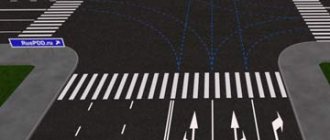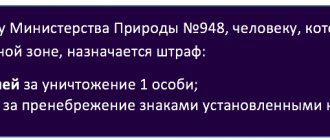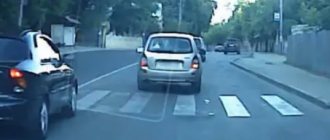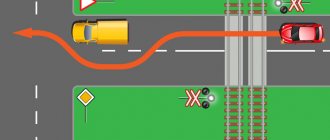What types of red markings are there, and for what purposes?
The types and rules for applying road markings in the Russian Federation are regulated by the Rules of the Road, which are approved by Government Decree No. 1090 and GOST 51256-2018.
In accordance with these documents, road markings can be:
- Depending on location:
- horizontal stripes, which are applied directly to the road surface
- vertical stripes applied to road barriers, poles, roadside elements, etc.
- Depending on the purpose:
- constant, valid regardless of the time of year, days of the week and other circumstances
- temporary, applied only for a certain period of time, for example, spring-autumn thaw or for the duration of repair work
The main colors of road markings are white and yellow. However, in real life you can also see red markings.
Red lines are drawn:
- as a temporary marking if the traffic service does not have orange. In this situation, the marking lines must be duplicated by the corresponding road signs
- to indicate the most dangerous sections of the road, which allows you to attract the attention of drivers. Markings can mark places where stopping or parking is prohibited, speed limits, and so on.
- to designate dedicated lanes that are intended for the movement of route transport. The solid line should be duplicated by the letter “A”
- to mark the boundaries of an intersection
- to designate a pedestrian crossing area. Red marking lines alternate with standard white lines. Such crossings are constructed on particularly dangerous sections of the road or when a large number of people with disabilities pass through (for example, near hospitals, hospices, etc.)
- to highlight bicycle paths and intersections of bicycle paths with the roadway. Red marking means that motor vehicles, which include road transport, are prohibited from crossing the specified borders
- to highlight pedestrian zones located along the roadway, for example, in the absence of curbs and sidewalks. Cars are also prohibited from crossing the continuous marking line.
- to designate sections of the roadway approaching a pedestrian crossing. As a rule, marking lines are applied to the road, located across the roadway. Glass beads are added to the paint to further attract the attention of drivers with a sound effect. In most cases, additional markings with a noise effect are applied to the road on dangerous sections of the road, as well as near schools, kindergartens and other educational institutions, hospitals, buildings with large crowds of people (shopping centers, cinemas, etc.)
- to highlight dangerous sections of the road or sharp turns, separating lanes in opposite directions. Vertical markings are applied to poles installed along the roadway.
The main meaning of red markings
There is no section in the traffic rules dedicated to red markings. Moreover, its meaning is not even mentioned. However, in reality such markings occur. The color of such markings is legal in Austria, Switzerland and Ukraine. There, a horizontal red stripe means repairs are being carried out on the road or a change in traffic for a certain period. Also, pedestrian crossings may be allocated to it.
Where to apply
The red lines are used in the same way as the orange ones. They are applied to the roadway, usually in areas of road work, repairs or traffic reorganization. Markings may prohibit maneuvers (for example, overtaking), indicate detours, limit speed, etc.
IMPORTANT! The red and orange lines are temporary, which means their requirements are a priority.
What does it mean
In Russia, red road markings mean approximately the same thing as in other countries. That is, it can be perceived as orange, temporary.
- A horizontal red stripe in combination with white dash-dot lines indicates the intersection of the roadway and the bicycle path.
- Directly on bike paths.
- If the lane is wide and completely painted in red, then you cannot cross it (like on a bicycle path).
- In combination with a pedestrian crossing, it indicates that collisions with pedestrians often occur in this area, so you need to be more careful.
- Near educational institutions with noise effect.
- The red color on the road surface can be used not only for markings, but also for applying road signs, for example, speed limits.
Any temporary marking lines can be marked in red. It is important to remember that it is not only the color that matters, but also the line pattern.
Related traffic signs
Red markings are usually used in conjunction with duplicate signs. The following must be installed in appropriate locations:
- signs indicating the approach or boundaries of a pedestrian crossing
- “Children” sign (installed in nearby places, kindergartens, schools and other child care institutions)
- The “Bicycle path” sign is installed in places where there are separate lanes for cyclists and where bicycle paths intersect with the roadway
- the “Road Works” sign is used to warn drivers about repair work and the presence of temporary markings
- signs prohibiting stopping or parking
- signs limiting the speed of movement on this section of the road
- signs warning of approaching dangerous turns
- sign warning of other danger
What is a median on a road, its meaning and purpose?
In order to create the safest possible traffic on busy sections of the road, a dividing zone is being established to delimit traffic flows. Thanks to elevated structures, it is possible to avoid vehicles from driving into oncoming traffic. On highways in Russia this element is mandatory. Equipping the roadway with a dividing strip provides a high level of safety on busy highways in the city and suburbs. Thanks to the towering structure, dashing drivers are deprived of the opportunity to carry out dangerous maneuvers or drive into oncoming traffic.
What to do if the markings are erased
Situations often arise in which the markings on the road are not visible (they have been erased over time, covered with snow, etc.), what to do?
When maneuvering in this situation, you must be guided by the road signs installed along the roadway, which duplicate the marking lines, and, in their absence, the traffic rules.
It is important to know that:
- If there are lanes for vehicle traffic, you can cross broken marking lines to overtake or get ahead.
- If there are more than four lanes on the road, there must be a double solid marking line demarcating the directions.
- U-turn is prohibited:
- at pedestrian crossings
- in the tunnels
- on overpasses and overpasses
- at railway crossings
- on sections of the roadway with a visibility zone of less than 100 m
- The maximum speed in a populated area is 60 km/h, and outside it – 90 km/h. The exception is highways and other sections of the road marked with signs;
- Overtaking is prohibited:
- at signalized intersections and at uncontrolled intersections when driving on a secondary road
- at pedestrian crossings
- on dangerous sections of the road and in areas with limited visibility (up to 100 m)
- in tunnels, bridges, overpasses and overpasses
- at railway crossings and 100 m before them
- Stopping and parking are prohibited:
- on the tram tracks
- at railway crossings and 50 m before them
- on bridges, overpasses, overpasses and under them
- in the tunnels
- at pedestrian crossings and 5 m before them
- at intersections and 5 m before them
- on dangerous sections of the road with visibility less than 100 m
- in any areas when creating interference for other traffic participants
- at public transport and minibus stops (except for boarding and disembarking passengers)
What do yellow road traffic markings mean?
What do yellow road markings mean? According to traffic regulations, yellow road markings 1.4, 1.10, 1.17.1, 1.17.2, 1.26 are also permanent. It’s not difficult to remember: there are only three types of yellow road markings, namely: a yellow solid line, a yellow broken line and, finally, a yellow zigzag line .
For those who are not in the know, the markings come not in two colors, as some believe, but in three colors: white, yellow and orange. In general, it can be said that such variety is used more for convenience than for any other purpose . So, the orange road markings are temporary.
Amounts of fines
Violation of the rules established by the marking lines is an administrative offense.
Liability in the form of a fine or deprivation of rights is provided for the following types of violations:
- For exceeding the established speed limit (Article 12.9 of the Administrative Code):
- for an amount of 20 km/h – 40 km/h – a fine of 500 rubles
- for 40 – 60 km/h – 1,500 rubles
- for the amount of 60 – 80 km/h – 2,000 – 2,500 rubles or deprivation of rights for 4-6 months
- for more than 80 km/h – 5,000 rubles or deprivation of rights for 6 months
- Stopping and parking at a railway crossing (Article 12.10 of the Administrative Code) – 1,000 rubles or deprivation of a driver’s license for 3-6 months.
- Driving to an intersection when there is a traffic jam (Article 12.13 of the Administrative Code) - a fine of 1,000 rubles.
- Turning around in a prohibited place (Article 12.14 of the Administrative Code) - a fine of 500 rubles.
- Driving on bicycle or pedestrian paths (Article 12.15 of the Code of Administrative Offenses) - fine 2,000 rubles.
- Driving into a lane intended for public transport (Article 12.15 of the Administrative Code) - a fine of 1,000-1,500 rubles.
- Drifting into oncoming traffic or tram tracks (Article 12.15 of the Code of Administrative Offences) – a fine of 5,000 rubles or deprivation of rights for 4-6 months.
- Failure to comply with the requirements established by markings regarding stopping and parking (Article 12.16 of the Administrative Code) - a fine of 1,500 rubles (for regions of the Russian Federation) or 3,000 rubles (for Moscow and St. Petersburg).
- Failure to provide an advantage to pedestrians at a pedestrian crossing (Article 12.18 of the Code of Administrative Offenses) - fine 1,500-2,500 rubles.
Red solid line on the road
- temporary horizontal markings are mandatory if road traffic needs to be reorganized for more than 3 days;
- when applying markings that redirect traffic flow, the position of the lines on the road surface must correspond to the line of installation of fencing and guiding objects on the site in accordance with paragraph 2.5.2;
- Temporary markings on the road must be made using orange demarcation material.
But unlike traffic police officers, judges are more loyal to those who plead guilty and impose the minimum punishment - a fine. But if you are firmly convinced that the rules were not violated, and the protocol was drawn up unfairly, start the “war” from the very first minutes.
Other color markings on the road
In accordance with GOST 51256-2018, other colors can be used for road markings:
- white. The priority color used for most permanent marking lines
- orange, primarily used for temporary markings
- yellow. Used to designate sections of the roadway where, for one reason or another, it is prohibited to perform such maneuvers as parking and stopping. Yellow lines also indicate stops for public transport (passenger taxis) and the boundaries of intersections (“waffle irons”)
- blue. Used to delimit the boundaries of traffic lanes, for example, at an intersection
- green. The primary area of use is duplication of installed road signs on the roadway
Road markings in Russia
Road markings of the Russian Federation
established by traffic rules. Complies with the Vienna Convention on Road Signs and Signals.
Story
For the first time, road markings in Russia began to be used in June 1933 in Moscow: in order to organize traffic, safety lines called “stutz lines” began to be applied with nitro paint. The first markings were applied to the roadway on Teatralnaya Square, as well as the intersections of Petrovka Street and Neglinnaya Street with Kuznetsky Bridge. Within two years, the markings began to be used in other cities of the country. Until the 60s, there was no clear unified legislative framework regulating the application of markings, until uniform traffic rules were introduced in the USSR. In 1975, the first GOST, based on international agreements, concerning road markings was published.[1][2][3]
Current road markings
The latest changes to the rules were made on June 30, 2015. Road markings comply with GOST R 51256-99 and GOST R 52289-2004. Modern road markings come in two types.[4]
Horizontal marking
Horizontal markings (lines, arrows, inscriptions and other markings on the roadway) establish certain modes and traffic order or contain other information for road users. Horizontal markings can be permanent or temporary. Permanent markings are white, except for lines 1.4, and yellow, temporary markings are orange.
Marking number Image Explanation
Lines 1.1 and 1.3 are prohibited from crossing.
The line is allowed to be crossed to stop a vehicle on the side of the road and when leaving it in places where stopping or parking is permitted.
Lines 1.5 - 1.8 are allowed to be crossed from any side.
Line 1.9 in the absence of reversible traffic lights or when they are turned off is allowed to be crossed if it is located to the right of the driver; when reverse traffic lights are on - on any side, if it separates lanes on which traffic is allowed in one direction. When the reversing traffic lights are turned off, the driver must immediately change lanes to the right beyond marking line 1.9.
Line 1.9, separating traffic flows in opposite directions, is prohibited from crossing when the reversible traffic lights are turned off.
It is allowed to cross the line from the broken side, as well as from the solid side, but only after completing overtaking or detour.
In cases where the meanings of road signs, including temporary ones, and horizontal markings contradict each other or the markings are not sufficiently distinguishable, drivers must be guided by the road signs. In cases where temporary marking lines and permanent marking lines contradict each other, drivers must be guided by the temporary marking lines.
Vertical marking
Vertical markings in the form of a combination of black and white stripes on road structures and elements of road equipment show their dimensions and serve as a means of visual orientation. Vertical layout:
Marking number Image Explanation
Red solid line on the road
Such a line informs the motorist about the edge of the roadway, and it is prohibited to cross it; ·The dotted stripe with similar intervals and strokes informs about the traffic lanes at the intersection; · Proximity strip. It is a line in which the strokes are 3 times the distance between the dotted lines.
- What are the dangers of crossing a solid marking line?
- Red road markings
- Penalty for crossing a solid line
- Penalty for crossing a solid line
- What is the fine for crossing a solid line in 2021?
- Penalty for crossing a solid line
- What is the penalty for crossing double solid lines?
- Penalty for hitting a solid marking line
- Crossing a solid line: fine 2021
- solid line
There is a solid red stripe on the road
It is prohibited to drive around vehicles standing in front of the crossing into oncoming traffic." According to traffic rules, horizontal marking lines 1.1, 1.2.1 and 1.3 are prohibited from crossing! As a result of violation of the requirements of road signs: 3.20 “Overtaking is prohibited”, 3.22 “Overtaking of trucks is prohibited”, 5.11 “Road with a lane for route vehicles”, 3.1 “Entry is prohibited”, resulting in traffic in the opposite direction on a road intended for one-way traffic , also constitute an administrative offense provided for in Part 4 of Article 12.15 of the Code of Administrative Offenses of the Russian Federation.”
The cameras are specially installed so that they record the vehicle almost at a right angle to the surface of the license plate. Material taken from https://narushaem.net/blog/likbez/270.html Stanislav (Yechiav) Question: Are you always deprived of your license for crossing a double solid line? Answer: No, not always. You can lose your license for overtaking and driving into the oncoming lane. In this case, there are no mitigating circumstances such as a slow-moving vehicle in your row, etc. According to the Rules, a slow-moving vehicle must press to the right and let you and all the cars that it interferes with pass through, and if it does not do this, then this is its violation. By overtaking him in the oncoming lane, you are committing your own violation, for which you are responsible. For this, as before, deprivation of rights.
We recommend reading: Benefits for family members of a deceased combat veteran
Types of temporary road markings
There are two types of road markings (traffic regulations, Appendix No. 2):
- Vertical.
- Horizontal.
The latter is presented in the form of lines, arrows, inscriptions and other symbols on the road surface. It is needed in order to establish the mode and order of traffic on the road or to reflect other important information.
Horizontal can be:
- Permanent - applied in one place and acts on an ongoing basis; It comes in white and yellow (1.4; 1.10; 1.17; 1.26).
- Temporary - used only for a while, most often in connection with repair work or replacement of the road surface, the duration of which is more than three days (GOST R 51256-1999).
It is usually highlighted in orange and can be used together with the permanent one. Sometimes yellow or red are used. For application, only materials are taken that allow quick removal, if necessary.
Its task is to warn drivers about the presence of a dangerous situation, changes in traffic flow, temporary changes in rules (it is forbidden to overtake, change lanes, stop, etc.).










